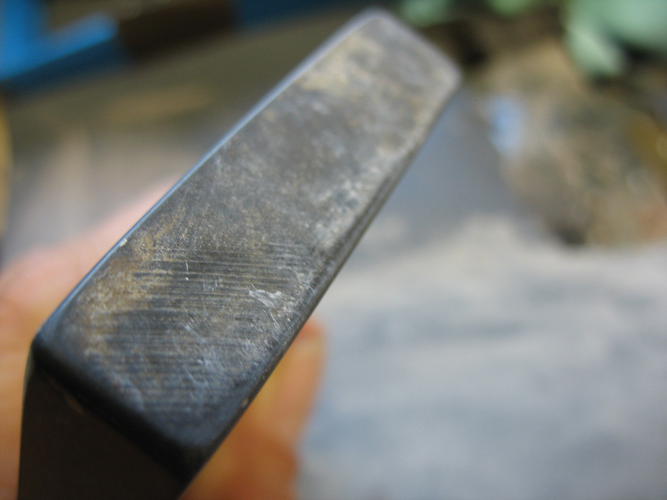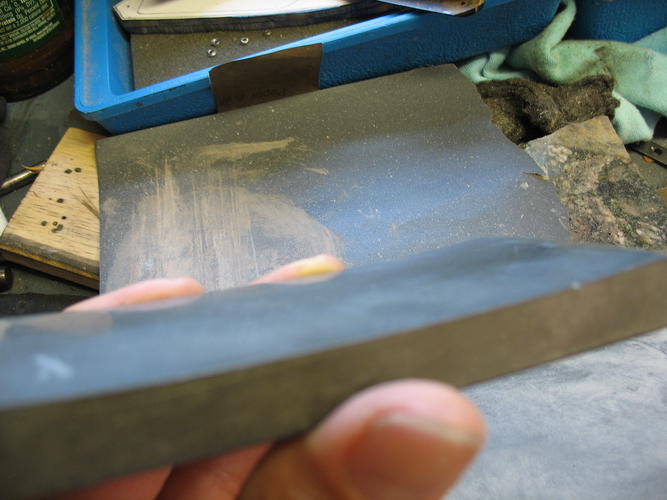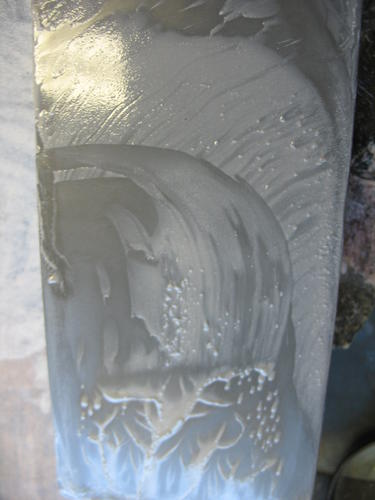Results 21 to 30 of 36
Thread: how to recognize a natural stone
-
07-12-2014, 11:22 PM #21

When I refer to manmade I refer to anything that's manmade.
I have a 12k water stone that is so old it came with a wooden base and I never tried it once with razors.
I only sharpened on it a few times. I tend not to sharpen blades on fine manmade water stones
They really seem to force you to strop other wise the edge doesn't seem sharp when feeling with the fingers.
The finest manmade I use is my shun 6k or king what ever grit the yellow one is not sure bought my two used
then I got natural.Last edited by Suile; 07-12-2014 at 11:24 PM. Reason: little error
-
07-12-2014, 11:31 PM #22

thank you all for your input. i did start to lap it on wet-dry and under magnification and the right light a can see little sparkly flecks (is that a good sign?) do you think i can lap it on my course DMT without damage to either the stone (if it is a natural) or the DMT? the wet-dry seems slow as there is probably .010 around the edges to go 'till it's flat. Also what would be the best way to use it (some testing with a old razor seems to indicate that its really fine grit) i tried it with just a spritz of water for the test.
-
07-12-2014, 11:44 PM #23

I kind of think you found a nice natural fine stone.
even if it's not it must likely would do the job of making your razor shaving sharp.
-
07-13-2014, 02:27 AM #24

If the stone rusts in a building with a lot of water in the air it is must likely
natural. unless they added something you don't want in the stone.
But the top side has the least damage from being old.
Is there a way to get the label off with out destroying it.
-
07-13-2014, 01:56 PM #25

Looks like it could be a slate hone of some sort. I don't know that I have ever seen a synthetic with saw marks on it but I could wrong, there's a lot of stones out there. You said you already bought it, I'd lap it and see what you have. Post pics of the sides, top and the top with a slurry made with a DMT or something.
-
07-13-2014, 02:52 PM #26

I don't think that Lynn is so far off, and maybe in his light hearted way he was giving you some leads.
Where did you buy it from, a vendor that sells auto repair stuff or a craftsperson who uses fine tools? Or was it a gift? This can be telling.
How old is the stone, is there a way to figure is this a 20th century monolithic stone (homogenous manmade) or an ancient stone with some uniqueness or quirks about it?
What is your experinece, roughly treated as a tool or knive stone, or somewhat gently as a razor hone?
Are you washed in water or oil, kept clean or gunky? Most synthetics that are older were advertised as oil stones.
Always look at that back first, where irregularities are sometimes left as natural. In the grain, are there colors, is the back and front the same grit, color?
Who are you related to, comparrisons are helpful. Most synthetics look bland, naturals have character if you can clean them up and study them. Asking here on the fourm if the stone is all cleaned and lapped with good photos on all sides can help.
It really is just guess work but actually using the stone for a while will help a lot to distinguish the stone character and original intended use. Ultra fine stones are always worth picking up if synthetic or natural so that is a no brainer, but ultra fine naturals will usually look like, but of course not always, like they were charished and used with purpose. Most naturals if not soaked in oil with have some organic odor when freshly lapped.
A few thoughts.
Alex
-
The Following User Says Thank You to alx For This Useful Post:
tintin (07-13-2014)
-
07-13-2014, 09:21 PM #27

here's some more images that might help. it looks like there was a label of some sort on the ends at one time. it doesn't smell like it was ever used with oil and it does have sort of a muddy smell when making a slurry.



-
07-13-2014, 11:48 PM #28
-
07-14-2014, 06:57 AM #29

Its natural [emoji106]
███▓▒░░.RAZORLOVESTONES.░░▒▓███
-
07-14-2014, 07:29 PM #30


 25Likes
25Likes LinkBack URL
LinkBack URL About LinkBacks
About LinkBacks






 Reply With Quote
Reply With Quote

